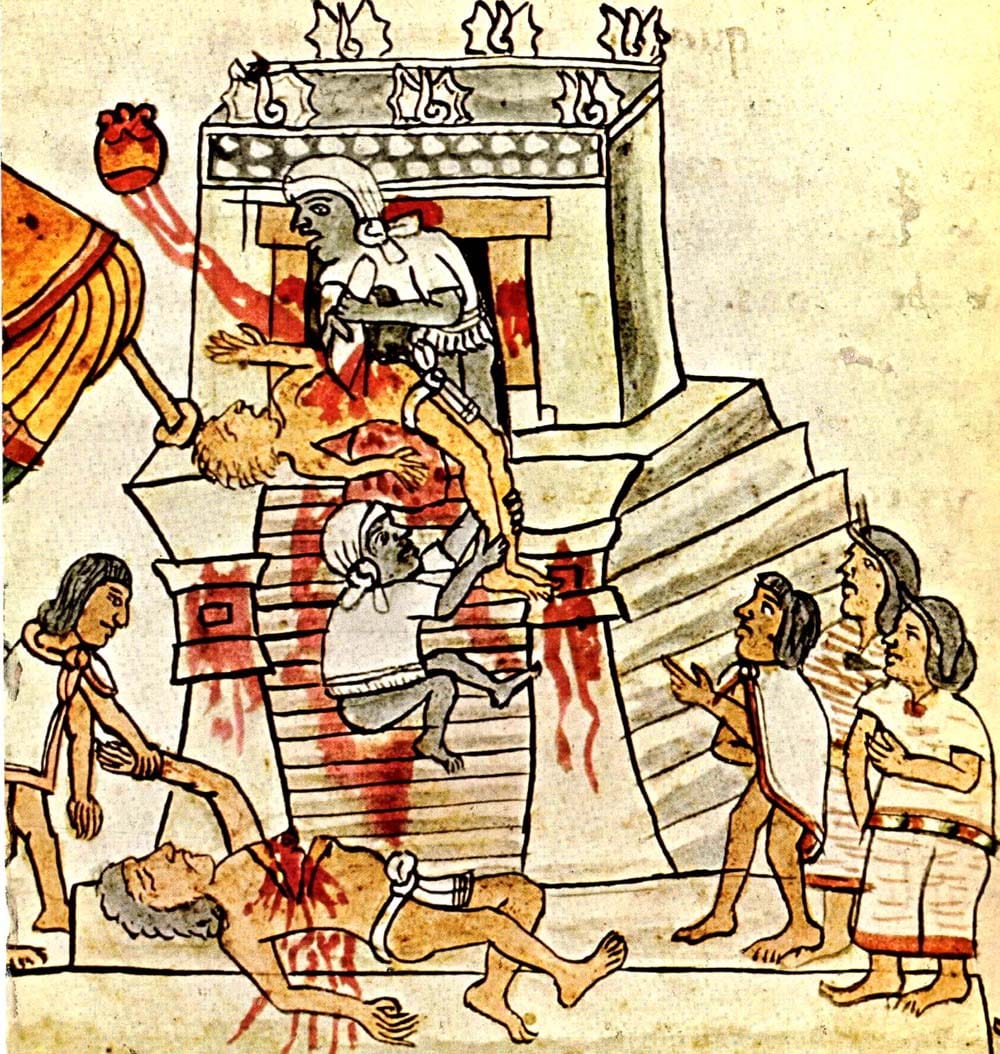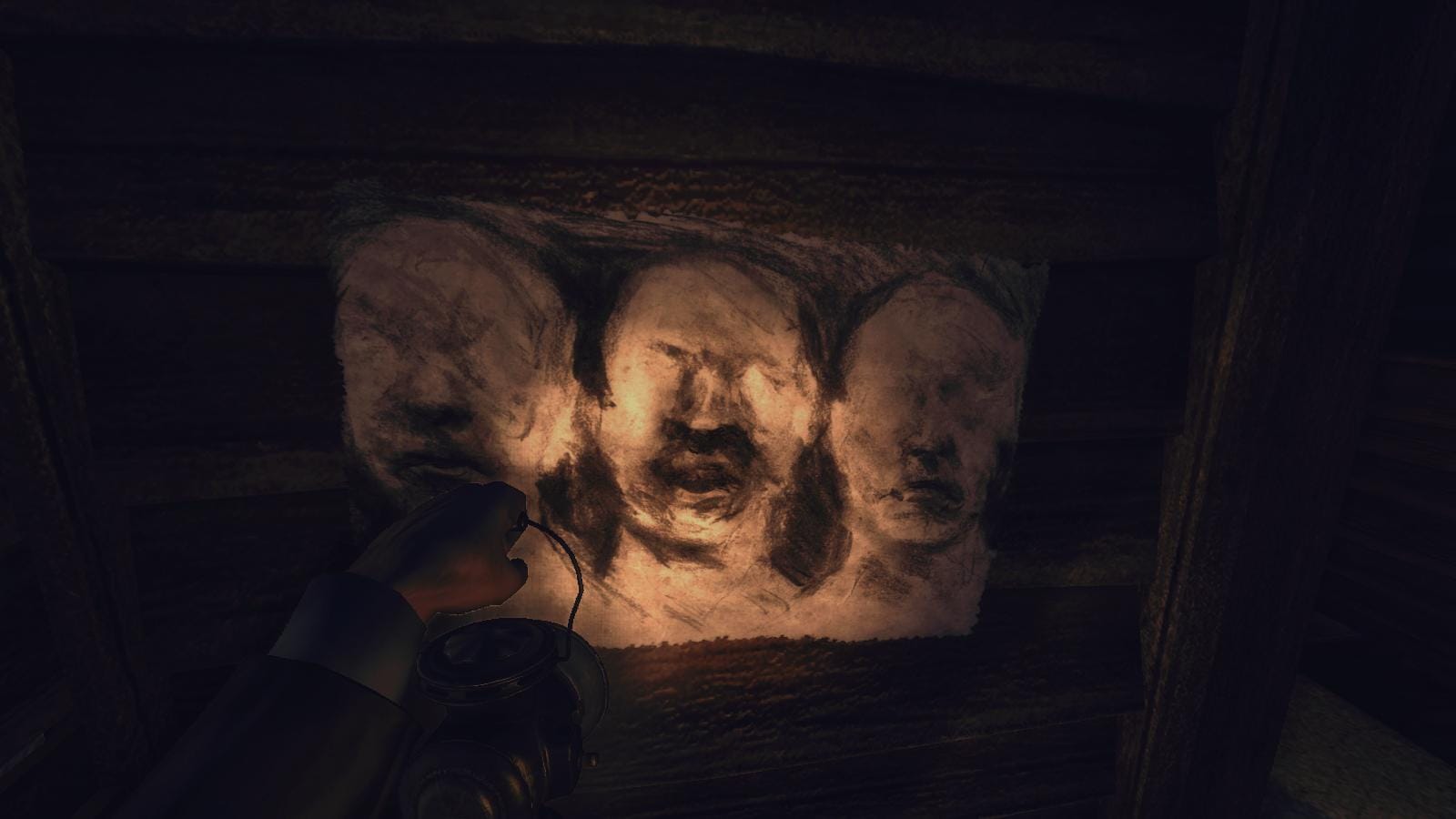“When, for instance, a man had fallen into one of the rendering tanks and had been made into pure leaf lard and peerless fertilizer, there was no use letting the fact out and making his family unhappy.”
—The Jungle, Upton Sinclair
We are familiar with Aztec myth only insofar as it is a byword for cruelty and human sacrifice. The image of the reluctant offering climbing the stone steps of the pyramids at Tenochtitlan only to have their chest cut open and their beating heart plucked out is repulsive to both the value we place in human life and our sense of decorum. This connotation is, to a certain extent, unfair: the purpose behind these sacrifices was not founded in naked cruelty, and they were, often enough, more symbolic than literal. Just as the offering was being flayed at the festival of Xipe Totec, so too did the audience peel off and offer husks of corn as a symbolic parallel. And yet the drama of grisly sacrifice finds an interesting thematic niche in 2013’s Amnesia: A Machine for Pigs.
At first blush, the videogame relies upon the dehumanization inherent to industrialization as a foundation for its horror. Its backstory reinforces this point: a well-meaning industrialist, Oswald Mandus, spends the bulk of his fortune on livable wages and safe factories, only to find that his prices are no longer competitive, his profit margins are non-existent, and he is in danger of losing everything. After discovering more unconventional ways of cutting costs (i.e., magic), Mandus becomes consumed with creating a grand machine that will cure the world of its inherent suffering. The game itself takes place on New Year’s Eve, 1899, when an amnesiac Mandus is told to enter the machine in order to rescue his children. During the descent, the player finds little models of Mesoamerican step pyramids scattered throughout the factory like an artist’s signature, and you cannot understand the precise horror A Machine for Pigs presents without knowing why they are present.
Our world turns because of the sacrifice of others
The Aztecs and other Mesoamerican civilizations ran upon the idea that sacrifice makes the world go round: by offering up the vital energy of the world, they were both following the gods’ example and giving the sun the momentum required to keep rising. At a distance, this thought is not so foreign to us moderns: we rely on the more or less figurative sacrifice of parents, teachers, friends, firefighters, police officers, doctors, and so on. It is common to say, upon meeting a soldier, “Thank you for your sacrifice.” We commemorate Remembrance Day (or Veteran’s Day) as an acknowledgement that our world was built on the sacrifice of those who came before. In a very real way, our world turns because of the sacrifice of others.
But this presentation is the idea in its most positive light. Our world also turns due to less glamorous, crueller, more exploitative sacrifices. Thanks to children mining cobalt in the Congo, I have a smartphone and a computer; slave labor in the seas off of Thailand feeds our cats. We can look further back for other examples: in the 18th century, the Enlightenment philosopher Voltaire acknowledged that the sugar he stirred into his tea was only possible because slaves were whipped in far-off Haiti; at the beginning of the Industrial Revolution, the poet William Blake wrote “that life liv’d upon death / The Ox in the slaughter house moans.” Both in the past and the present, our world runs on the engine of human suffering—as Blake puts it elsewhere, we all drive our carts and plow over the bones of the dead.

Aztec Human Sacrifice – Wikimedia Commons, Public Domain
There is a difference, of course, between the voluntary sacrifice inherent to service and the compulsory nature of slavery and slaughter, just as there is a difference between the voluntary offering of one kind of Aztec sacrifice and those of the prisoners captured in various Flower Wars, or in the purposeful massacre of civilians and the accidental death of a factory worker. But A Machine for Pigs does not parse the characteristics of these sacrifices: in an industrial system, quantity matters over quality, and the blood is just as red no matter how it is spilled. Further, perhaps it is mistaken to view these cruelties as causal, but our world functions in no small part due to the suffering of others. This fact is not necessarily the intent of the systems we have in place, but nevertheless the world turns while men and women bleed; it is no great sin on the Aztec’s part that they mistook correlation for cause.
This Aztec theme runs through the entirety of A Machine for Pigs: the first phone-call names Mandus as “Precious Eagle Cactus Fruit,” the name given to the heart pulled from the body of a sacrifice. As noted above, there are miniature models of step pyramids scattered throughout the factory. Mandus refers to himself as various Aztec gods: “I am the jaguar-faced man,” or Tezcatlipoca, the deity associated with obsidian, the material used to craft the sacrificial knife. “I am the feathered serpent,” or Quetzecoatl, a patron deity of the Aztec priesthood. As an industrialist, he is the one who oversees the sacrifice of factory workers, which pump out the products that are bought in stores and give the modern world its momentum. It is only appropriate that he identifies himself as the one who carries out that sacrifice: “This priesthood is mine… I carry the knife of this factory, the bowl of this mill.”
A trip to Mexico is repeatedly mentioned in the flashbacks, and the player eventually learns that Mandus, standing on the stone of a Mesoamerican ruin, received a vision of his two sons dying in the Somme some 16 years hence. And so he kills them to spare them that horror. The references grow only more and more overt as the game progresses: near the end of the game, the player crosses a lake of blood to reach a sacrificial altar. Later she climbs a step pyramid while the voice of the machine gives the game’s most memorable monologue:
I have stood knee deep in mud and bone and filled my lungs with mustard gas. I have seen two brothers fall. I have lain with holy wars and copulated with the autumnal fallout. I have dug trenches for the refugees. I have murdered dissidents where the ground never thaws and starved the masses into faith.
A child’s shadow burnt into the brickwork. A house of skulls in the jungle. The innocent, the innocent, Mandus, trod and bled and gassed and starved and beaten and murdered and enslaved!
This is your coming century! They will eat them Mandus. They will make pigs of you all and they will bury their snouts into your ribs and they will eat your hearts.
This monologue points to where the Aztec theme melds with the game’s more conventional display of the inhumanity of industrialization: mustard gas requires a chemical industry, while the autumnal fallout of Hiroshima needed a total war economy. But the list of horrors extends backwards through time as well. The fall of the two brothers refers simultaneously to Cain and Abel or to Mandus’ boys, Enoch and Edwin. Starving the masses into faith is similarly ambiguous. Are we talking about Aleppo in 2016, or Toulouse in the 13th century? By going backwards and forwards, the list of horrors incorporates the scope of human history; the ease with which the results of the industrial revolution are incorporated into that pattern is then meant to be disconcerting. More troubling still, there is an uneasy interplay between sacrifice and the sacrificer in the shifting image of the pig: they will make pigs of the victims, but the victimizers all have porcine snouts. It is not merely that those who exploit and those exploited are not as far away as we might imagine; it is that the two are utterly indistinguishable. As Mandus notes in a flashback, “We are the pig, professor. We are all the pig.”

There is a reduction present in A Machine for Pig’s use of the Aztec mythos. Absent are the regenerative aspects of the repeated references to sacrifice. The promise of renewal and growth in the flaying of a man are left out in favor of the grim spectacle of the flaying itself. Instead, the game relies upon the eternal recurrence of this sacrifice and the assumption that correlation—the world turns as humanity bleeds—implies causation—the world turns because humanity bleeds—for its horror. The narrative of the game is then based on the decision of a businessman who decides that the benefit is no longer worth the cost and tries to liquidate the whole endeavor. The logic of industrial capitalism then becomes indistinguishable from driving sacrifices up the steps towards the stone altar.
But the darkest part of A Machine for Pigs is the lack of an intrinsic moral force to its horror, the disinterested quality of its presentation—like a structural engineer professionally examining the blueprints for an abattoir. It would be easy to accuse it of possessing a kind of adolescent nihilism—e.g., “life is suffering, and we’re all going to die,” a sentiment common in Final Fantasy villains—were it not for its reliance on the most reductive and basic of presentations: human lives as mere flesh. Its presentation of this first principle—that we are first and foremost animals—is both irrefutable and disconcerting in its implications. In the Aztec model, this means we are subject, like the rest of the world, to the recurrent cycle of death and rebirth; in A Machine for Pig’s model, we are merely another resource to keep the engine churning.
Our world runs on the engine of human suffering
But beyond its fusion of Mesoamerican myth and modern industrial thinking, A Machine for Pigs is a negation of the perennial optimism inherent in Western progressivism, where we perpetually assume that things are always getting better, things are always getting easier, that we are becoming better people than those who came before us. Those at the cusp of the 20th century were not so different from us, and they believed in this sense of progress too. Yet still there were the countless dead of the Somme and Verdun, the Holocaust, and the massacres of the Khmer Rouge or at My Lai. The game avoids any kind of western-centric view in noting these horrors, as we are wont to do when providing self-exculpatory explanations like a “medieval mentality” or “ideological zealotry.”
Indeed, A Machine for Pig’s placement during the aftershock of industrial revolution and the turn of the 20th century establishes firm parallels between then and now: we are only 16 years away from our own turn of the century, and still riding the waves of the digital revolution. And yet children still die in vents and factory collapses and African mines. We are not so far away from the predicated suffering of the 19th century, and earlier. A Machine for Pigs doubts we will ever be.





